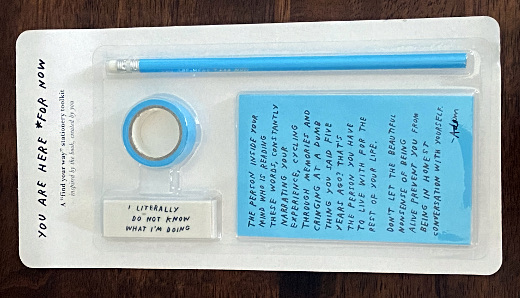Livestreaming Swim Meets – What I Learned So Far And What’s Next
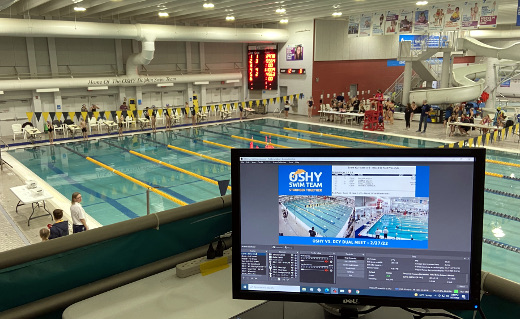
To say video has played a greater role in our lives over the past few years is an understatement. From Zooming friends to work meetings, social functions, sporting events and even religious services virtually, it has become a new normal in our lives. Even with lockdowns being lifted in many areas, there’s still a desire for livestreaming of some events. For those who are still cautious when going out to the grandparents on the other side of the country who can now watch the grandkids in ways not possible before, we will be looking to our screens for more of life’s activities.
The sport of competitive swimming is no exception to it. When lockdowns were put in place, the sport suffered greatly. Some teams ceased to exist altogether when the availability of pools they rented was no longer possible. Others scaled back tremendously and those who came back did so with restrictions, all in the name of getting people back in the water to participate in what I consider one of the greatest activities of life. As large crowds watching meets in person wasn’t going to be a thing, like other events and sports swim meets were livestreamed online.
Last year, after getting municipal and other clearances, we literally had four (4!) weeks to put on the summer swim meets I have been proud to be a part of in Appleton, Wisconsin, the Fox Cities Summer Classic and Bird Bath Invitational. Part of the approval was a limit on the number of people who could be on the pool deck, which meant spectators would have to watch from outside of the fenced in pool area. This is where livestreaming came into play, and I had that same amount of time to not only figure what to do, but make sure it all worked when the first horn was sounded at the meet. With help from friends, trial and error and online resources, it all came together. Since then we have evolved our technology and have streamed several club and high school meets and a championship too.
As I prepare for this year’s summer meets, I am sharing here what I have learned so far, in hopes it will help others who are looking to start or evolve their own livestreaming. I am also sharing plans for the future, and welcome input from those who have been there or are on a similar journey. Note that where the focus here is on swim meets, the same principles can be applied to livestreaming just about any event.
But before I begin, I have to acknowledge that if it wasn’t for fellow Swim Dads Dave, Jeremy, Bruce and Brian, nothing I am writing here would have ever happened.
The Premise – What is Livestreaming a Swim Meet?
Where I had observed how other pools and teams were doing their livestreaming and had some distant familiarity of the technology involved, I had never livestreamed a multi-day, outdoor swim meet in a 50-meter pool before. In order to solve a problem, you need to define what it is. Our goal was to setup cameras and supporting hardware and software to livestream our swim meets for people to follow the meet and know where in the meet we were.
It was that simple... from a premise point-of-view. But as it always goes, the devil is in the details. Below I get into said details on each component that combined made a livestreamed swim meet a reality.
The Software – OBS
Of the few livestreaming setups I observed, they were all using OBS, or Open Broadcaster Software. It is open-source software that runs on a PC, Mac or Linux-powered computer. OBS allows you to use multiple input sources – video, audio, images, text and even Web pages – to build a “scene” or what will appear in the livestream. You can create a number of scenes and move through them. For example, you could have a welcome scene that is just text and an image, a scene that has one camera and another that has multiple cameras.
Where I didn’t know exactly what the livestream would look like, right away within fifteen minutes I was able to download, install and start OBS and include my MacBook’s Webcam into a scene, which is as basic as you could get for livestreaming. I then switched to an external Webcam and it worked as well. When I plugged in a second external Webcam, my MacBook’s fan kicked into high gear. After looking more into OBS hardware requirements, I realized what I had for a computer wouldn’t cut it for actual livestreaming, as we would need one with much more horsepower.
The Hardware – A Gaming-Like Computer
After discussing my hardware dilemma with our swim meet team, a friend came through and helped create a machine much more suitable to the task. We have a Windows 11 PC with a fast CPU, maximum memory, a decent sized hard drive and an NVIDIA graphics processor, the latter being the key piece needed to run that much video all at once. From the above hardware requirements and other research I did, I found there is not one optimal hardware configuration, as it varies by factors including if you are going to be recording the video on the computer as well as streaming, the number of inputs, etc. In the end we have something similar to a gaming PC, and it has served us well.
The Cameras – Webcams and Mounting and Stretching the Limits of USB
From other livestream setups I observed, they employed HD Webcams as video sources. A friend had 2 Logitech Webcams and we used them alongside the pool and near each other as our video sources. You can use other types of cameras, including traditional video cameras, but we didn’t have them at our disposal or the budget to acquire them. We also had a couple of other HD Webcams as backups. For the high school meets later last Fall we wanted to place the wide-angle Webcam at the turn end of the pool and needed one with a wider angle, as the cameras we had didn’t capture the full width from the turn end of the pool. To get it all in, we got a Webcam with a 120 degree angle lens.
With the cameras in place, we quickly realized we would need a longer cable than the 3 foot cord attached to the Webcam. For this we did a lot of trial and error and acquired several USB extension cables. We learned that you can use a 25’ cable just fine, but if you need something longer, the cable has to be powered in order for it to work. To this end we got 50’ USB extension cables and they worked great for the summer outdoor livestream. A challenge to them was the power source was closest to the Webcam, so we needed to run electric extension cords along with the USB cables. From where we positioned the PC for the school meets, even a 100’ cable wasn’t long enough to reach the turn end of the pool. Fortunately we found this USB extender that used a standard Ethernet cable to get a reach of up to 165’ which was more than enough to reach a great position for the camera.
When we figured out the camera angles we desired, we had to mount the Webcams in a way where they were stable and provided access if needed. For the summer meets, it was on canopy stands that had special painting that couldn’t be scratched. For the first of the 2 summer meets we used a low-budget yet highly effective mount using plastic cups to shield the cameras from the elements, using zip-ties to secure the cameras on the canopy stand position that was wrapped with a towel to prevent scratching. For the next meet, we got a Swim Grandfather involved and created mounts with PVC pipes and tripod parts for a more secure and elegant solution.
As we moved indoors for high school and club meets, we had to rethink mounting cameras. Large Gorillapods were used to secure a camera to the armrest of a lifeguard stand (out of the way of the lifeguard!) and a long PVC pipe was secured to a wall to position the wide-angle camera at the turn end of the pool. Duct tape and long zip ties helped both the indoor and outdoor camera mounts succeed.
A quick note on audio – we decided for the summer meets to not use it. Based on the rules of the livestream platform we chose – see below – if we streamed music that we didn’t have the license to do so, we could get dropped from the stream and could even lose our ability to livestream altogether. In later high school meets we incorporated a USB microphone for play-by-play, however when the mic was off there was no sound in the livestream, as we turned off the input of sound from the Webcams in OBS.
The Scenes – Scouting and Designing
With hardware, cameras and cables in place, it was time to design the scenes for the meets. In all cases from the summer outdoor meets at a 50 meter pool to the indoor high school and club meets at a 25 yard pool, we first scouted the scene to determine where we could possibly place cameras and our equipment. For the summer meet, the 2 Webcams we used crossed each other, so that we could get the entire pool into the one and only scene, as shown below.
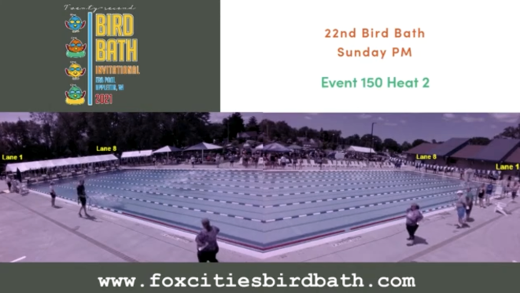
Where it wasn’t the be-all, end-all of scenes, it did the trick. We also incorporated other elements including the event logo image, text with the URL for the meet Web site and a Web page that listed the event and heat that was continuously updated throughout the meet. In the image it may be hard to notice, but we added text labels to identify lane 1 and 8, a request that came from several parents who didn’t know which way the lanes were numbered.
Feedback was generally positive on the livestream, as parents were watching on their phones from their “camp” in the park surrounding the pool and would make their way to the fence to watch their kiddos swim. One grandparent lived within walking distance of the pool and was watching at home and walked over in time to see her granddaughter. Where we went in with a “better than nothing” baseline, we decided to run the same setup for both meets which were less than a month apart, and brainstormed throughout the meet on how to make it better.
For the high school and club meets we livestreamed over this past Fall and Winter, we deployed some of this ideation. This included full-screen video from a single camera and switching scenes to follow the progress from the blocks to the turn-end and back. We also experimented with other multi-camera scenes and effects like adding an opaque filter over the picture during warmups.
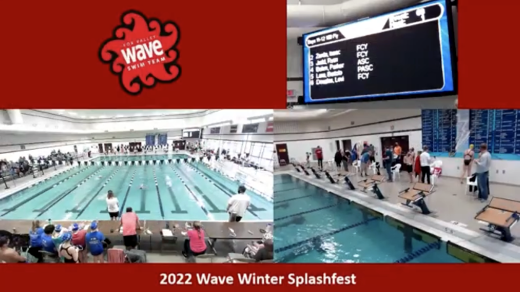
The Streaming Platform – YouTube
Any of the above work we did would have been useless had it not been for the content delivery network, which is how the video gets from the computer to whatever screen someone is watching on. The decision of going with YouTube was an easy one – a user experience known by all, ease of integration with OBS and it is free. I tested this first with my own personal YouTube account, and eventually with one for the meet and on existing accounts for the high school and club teams where the other meets were hosted.
Livestreaming videos are found on the channel page for a YouTube account. If you have never uploaded a video to YouTube or livestreamed, there’s some setup you need to do. First, create your “channel” or home page at YouTube, then go thru the process of trying to livestream – you will be prompted to “apply” for it, and you will have to wait at least 24 hours for the ability to do so. In this spare time you can make your channel more appealing with an avatar, banner image and upload at least 1 video – this will help with your channel being found. For the YouTube channel for the summer meets I posted a coming soon video last year and this year, and for the club team whose meet I helped livestream over the winter I was able to create a simple video with their logo. All of these I made with free tools at Canva.com and so can you. I also configured the channel page so that livestreamed videos in progress would appear at the top of the channel.
When you livestream on YouTube, share the link to the channel, not to a particular video. Why? You may have separate videos for a morning and afternoon session. In the worst case if your video cuts out, it will end and restarting the stream will start a new video with a new link. As for that channel link itself, your initial one will be a long stream of characters after youtube.com. In order to make a vanity or custom URL, you need 100 subscribers to your YouTube channel. I was able to get this for our summer swim meets by sending an email to my friends asking them to subscribe!
The Connectivity – Fast and Available
Even with all of the above you don’t have a decent livestream without sufficient bandwidth. After research I learned an upload speed of 20 to 25 Mbps is ideal. Where I have it later on the list, it ideally should be one of the first things you look into at the venue where the swim meet is being held – trust me on this, as I learned this the hard way.
To make a long story short, we assumed we could plug into an Ethernet port at the pool where we had our summer meets, and we could not. Fortunately the city’s IT director came through for us literally 2 days before the meet and he gave us a separate SSID (or hotspot) on the wireless network at the pool that had sufficient bandwidth. We had a similar issue at the high school pool as they would not allow us to plug in our gear as it wasn’t owned by the school district, and fortunately the wireless network that the school used (not its guest SSID) was sufficient.
As you are livestreaming you should be watching the livestream “health” – both OBS and YouTube allow you to monitor it and will alert you when there’s a bandwidth issue. I also have the Ookla Speedtest site bookmarked on my livestream PC to test it in case there’s an issue. This will allow you to discover if there’s a problem with the network before frantic parents start texting you about it.
Integrating The Scoreboard – A New Addition
Even with all of the above in place and humming along, the actual swimmers look tiny in the video, even on a large TV. But knowing what event, heat and lane your swimmer is in goes a long way with the swim meet watching experience. For our summer meets as mentioned previously, we had a Web page with the event and heat. Where it was less than ideal – the page refreshed every 20 seconds or so, thus not always in sync with what was in the water – it was good. Integrating the actual scoreboard of the meet would make it great.
For the most recent meet, as pictured at the top of this post, I was able to integrate a Web version of the scoreboard that was generated by the timing console software from Superior Swim Timing, or SST. The swim console syncs with the meet management software to get the event, heat and lane information (including who is swimming in what lane) and outputs it to a physical scoreboard at the pool. The Web page it generates was pulled into the OBS software and I was able to display it in a scene, something requiring the OBS timing console computer to be on the same network as the livestreaming computer. As you can literally crop all elements in a scene, for the next meet (as I didn’t think of it ahead of time) I can literally crop to 1 line of the scoreboard Web page, where it displays the event and heat, and include it in all single camera scenes.
Tips from The Field
Beyond the hardware and software and sweat that goes into livestreaming, we learned some lessons along the way to ensure the livestream was up and running as we would like, which meant as parents and families would like.
Test, test, test – Just like voting in Chicago, you need to test early and often. As we setup our computer and start plugging in cameras and a microphone, we would test to ensure a signal was coming from the device. We would start the livestream early and monitor it’s “health” – was there video coming from the cameras, viewable in OBS and being sent to YouTube and was the Internet connection consistent. We watched the livestream on our mobile devices, ideally using our cell network, to ensure others could see our stream.
Restarting OBS – As we are dealing with computer technology, something is bound to happen. We had issues where the color balance of one camera would suddenly be off. A few times we had a camera’s video “freeze” on us for no apparent reason. At first we tried adjusting settings but this usually made the picture worse, or not come back at all. What did work was restarting the OBS software – literally closing the program in the middle of a livestream, and quickly restarting it. When doing so, and clicking away the warning message, it will take a matter of a few seconds to do so, and it was surprising how everything was back to normal. Doing it this quick also had little to no impact on the stream itself – we found there’s about a 10-second delay throughout the stream from what is actually happening to what you see on your mobile device or other screen. Through the restart process it may briefly freeze to the end user, but then it comes back quickly.
Have backup equipment and power cords – As software can fail, so can hardware. We have several backup Webcams, cables, power cords and other supplies at the ready for whatever could reasonably happen.
Stay thirsty, my friend – While monitoring an active livestream was when we would come up with other ways to make the actual video experience better. Sometimes we were able to do this in real-time by editing scenes, other times we made notes for the next swim meet.
What’s Next?
Work has been in process for this summer’s meets, including livestreaming. The following is the short list of things I have in the works to make improvements to the livestreaming process and view experience.
Deeper Learning of OBS – A few clicks around the settings of OBS will tell you there’s a lot to this software. I am actively learning more of the inner workings of this software by taking online tutorials and looking for other tips on YouTube as well. As much of we have done was driven by what we wanted to see, now I am going from the other angle to learn what is possible and if and how to apply it.
Networked and Other Cameras – The HD Webcams have worked well for us, but one challenge we have is not being able to use more than 3 video feeds. Where I am not certain, I believe this may be a limitation of the computer to process that many USB inputs. For this reason I am exploring working with IP networked cameras. Each of these cameras would have an Ethernet cable coming out of them and going into a central hub or router, the same one where the livestream computer is connected. We are testing this on fixed cameras, but using IP cameras allows us to use PTZ (or pan-tilt-zoom) cameras, where we can go beyond a fixed camera view. Extending this, we are also going to try using traditional HD video cameras in the mix.
Audio – As I said before, we turned off the audio so not to have to be worried about losing the ability to livestream in the event unlicensed music came across the stream. But it goes without saying how audio enhances the video experience. I am looking how to incorporate the meet announcer’s microphone into the stream, as well as having the “background ambient sound” of a swim meet to cut the dead silence. As the acoustics of a natatorium are not ideal, I am exploring the audio settings in OBS to filter it so we get good sounding voices clearly over the stream.
Incorporating other scoreboards – Beyond the SST software, there are other scoreboard system in use for the meets we will be livestreaming. I am hoping to connect with IT departments and manuals for those systems to see how we can incorporate their digital signal into ours.
Lane graphics overlays – Make no little plans was the mantra of Daniel Burnham, so why not be the mantra of swim livestreaming? There are systems available to overlay graphics onto the pool as you would see on a TV broadcast of Olympic swimming. One example of this is Streamline Tech where the meet manager software incorporates with the overlay software so the names of the swimmers and their team logo can be displayed. Visit the link to see what this looks like – talk about taking the video to the next level!
Eventual turnkey solution – Everything that has been talked about in this post is stored in three large totes that are trucked into and out of the aquatic center where the meet is being held. It takes a good amount of effort to place the computer, mount cameras and to test and ensure all is in place for a meet. Add to this the knowledge of using the OBS software and troubleshooting if an issue comes up. Where I hope to train and get more Swim Dads (and Moms and Siblings) involved in this as time goes by, ideally for livestreaming to be as commonplace as a digital scoreboard it needs to be made into a turnkey solution, where you literally plug it in and it works. We’re not there yet with our tote solution, but introducing fixed cameras into facilities and appropriate connectivity will take us towards this.
Deconstructing Livestreaming a Swim Meet
As a proud Swim Dad I have been even prouder to be involved with the livestreaming of my kiddos meets. It has made these events accessible to a wider audience and will continue to do so as it is almost an expectation that a livestream feed will be available. Where I and our crew have learned a lot and been successful, we realize there is more to learn and enhance the back-end and front-end experiences. I hope this lengthy piece is of value to you who have read it to this point, and I welcome your own thoughts and lessons learned if you have gone on a similar journey for livestreaming, whether it’s a swim meet or any other events.
This is from The Hot Iron, a journal on business and technology by Mike Maddaloni.
Did you enjoy this? Subscribe to The Hot Iron by RSS/XML feed or Read by Email
(0) Comments • PermalinkMy Takeaways From The Book How To Live

If you were to ask different people a question – any question really – you would likely get different answers. Why? The answers would be based on, at a minimum, the knowledge and philosophy of that person. As no two people are quite the same, this would apply to their thinking and response to your questions.
Continuing this logic, if you were to ask one person a single question, you would expect only one answer. Right? One, not 27. The multitude of answers to one particular question, how to live, is the premise of the book aptly titled, How to Live by Derek Sivers.
Sivers is a serial entrepreneur, author and musician whom many people know as the creator of CD Baby. I have been following him and his blog for years, where he shares his opinions on business, tech and life, especially as he has lived in many countries around the world. When How to Live came out, I was intrigued by the topic and picked up a copy from his Web site as he self-published and self-distributed the book.
With a subtitle of “27 conflicting answers and one weird conclusion” the book lives up to it, with thorough, well thought-out answers that range in extremes from “do nothing” to “make change” to everything in between. As I read through the answers, I had many takeaways from the book.
It’s good to see things from multiple points of views – This is something that I have recollections of, where I saw all sides of an issue and was able to work a situation to my advantage. On the flip side, there were times I didn’t see an issue from all sides and it came back to bite me or worse yet be an opportunity that slipped away.
The impact of change is relative – When I moved from Boston to Chicago, a friend opined I must have great courage to up and move as I did. I chuckled and responded that it wasn’t courage as much as a desire for a change of scenery, something both my wife and I sought out in our quest to the US Midwest. As I read through the answers in this book, I thought of this and even did a rough measurement of what the impact of might actually be of the answers.
Seek advice but make it your own – I recall a certain comedian/actor known for promoting a certain brand of pudding snacks once saying that when you give someone advice it is now theirs, and what they do with it is up to them and not on you the giver. In all of the answers in How to Live it provides a plethora of suggestions for what you can do, though likely you wouldn’t follow each to the letter.
How to Live is a short (~120 pages), quick and enjoyable read, and one that will get you thinking. Thinking not only of options of how to live your life, but the effort and thought process that went into writing such a book. It’s a good book for anyone to read from teens to well-beyond-teens. As I share all books, I am leaving this at Stateview Commons, the co-working space I currently work from. Perhaps one of my fellow co-workers will find it as interesting as well.
This is from The Hot Iron, a journal on business and technology by Mike Maddaloni.
Did you enjoy this? Subscribe to The Hot Iron by RSS/XML feed or Read by Email
Book Take-Aways • (0) Comments • PermalinkAppleton Wisconsin Community and Tech Industry Resources
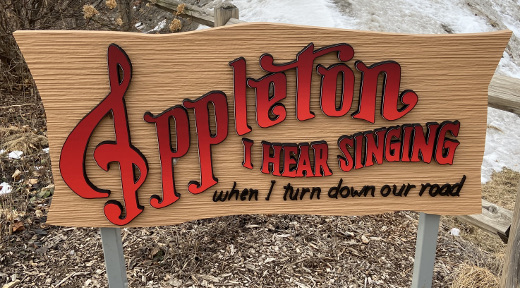
Recently a friend moved to Appleton, Wisconsin, the city where I live. Like me he is in the tech industry, so I started forwarding him links to Web sites and other resources in the community to help him get acclimated in his new community. I also logged them and am sharing this list here to a greater audience.
By no means do I believe this is the be-all, end-all of what is out there and going on in Willem Dafoe’s hometown – if I left something out, please leave a comment to this post. I have organized these into community and the tech industry, and they are in no particular order. Though many of these outlets have a social media presence, here I have listed the traditional ways of how to reach them, highlighting their Web sites, email lists and RSS feeds.
Community Resources
All Things Appleton – In the last year or so this site came onto the scene and is dedicated to the finer details of the inner workings of city government you can’t find elsewhere. It is frequently updated and has an email list and RSS feed.
Appleton Post Crescent – The local newspaper is among most all major papers in Wisconsin that are owned by Gannett and fall under the USA Today banner. Where the changes in the newspaper industry are evident in its publications, it does encompass most of what is going on. They offer email lists and RSS feeds, and much content is available without paying for a subscription.
Appleton Magazine – This is a monthly lifestyle magazine covering the greater Fox Valley and features people, dining and entertainment. Much of the content is available on their Web site and it has an RSS feed, and you can pick it up the paper version in stores and restaurants or subscribe by mail for a nominal cost.
GB News Network – GB stands for Green Bay, which is a short 30-minute drive north from Appleton. This is a news and events site for the Green Bay area. You can also subscribe to their weekly email for the latest information leading into the weekend.
Appleton Public Library – The city’s one and only library is in the midst of a metamorphosis, where the current building will be expanded and reimagined, and in the interim the library will be temporarily in a former Best Buy store. Their email list is a great way to keep up with the comings and goings over the next few years and beyond.
Go Valley Kids – As a parent of young kids this Web site is a go-to resource for family-friendly activities in the area. Their Web site lists current activities and events, but what I find the best is their robust archive of evergreen places both indoors and outdoors, especially for those times when you can’t think of what to do with the kiddos. Subscribe to their email newsletter for the latest news and events plus they have recently launched a podcast.
Fox Cities Magazine – It’s nice that there’s more than one monthly lifestyle magazine in the area, and this is another. You can read entertainment and activities listings on their Web site, though their RSS feed is infrequently published to You can also pick up the paper version at restaurants and stores or subscribe by mail for a low cost.
Appleton Downtown, Inc. – The business association for the downtown/College Avenue area, their site offers events and business profiles for that area. In addition to their Web site they offer an email newsletter and RSS feed.
Fox Cities Chamber of Commerce – This is the largest Chamber in the area and features events plus business listings (hint: restaurants are a business!) in the area.
Appleton Historical Society – If you want to dive deeper into the history of the city, this is a place to visit. What looks like an old house has a wealth of displays and photos of the city over the years and hosts events on various aspects of that history.
History Museum at the Castle – Formerly a Masonic temple (thus the name “castle”), the museum has a mix of historic displays of the area as well as traveling exhibits. A must-see is the permanent exhibit on Harry Houdini, who lived in Appleton in his younger years, and tells the secrets of many of his magic tricks.
TGVG – The Greater Valley Guide – This printed publication and Web site is primarily focused around sports activities but also includes a variety of other kid-related events and things to do around the area. They offer separate RSS feeds for their blog and events.
The Wheeler Report – This is a Web site that aggregates news stories from across the state of Wisconsin and is centered on state and local government. They used to have an email newsletter but stopped it for some reason, but this is a site to bookmark and visit daily.
Mile of Music – As the photo above mentions to singing, it’s likely referring to the beginning of August for this week-long music festival. Artists from around the country and the world converge on Appleton for this music festival which some compare to the SXSW music festival in Austin, Texas. They offer a mobile app during the festival to set your entertainment schedule.
Flag Lowering Orders – A little outside from the others here... but if you have seen a flag at half-staff around Dairyland and wondered why, subscribe to the email and text alerts and be in the know. Alerts cover all orders that pertain to the state, including from the federal level. This is useful as Wisconsin Governor Tony Evers seems to issue an order almost weekly if not more often.
Tech Industry Resources
Insight on Business Magazine – This is a monthly business magazine that covers all business in Northeast Wisconsin. You can subscribe to its print version, read online and subscribe to their email newsletter.
IOM – A sibling publication of Insight on Business, it focuses on – you guessed it – manufacturing in the area. As well, you can subscribe to its print version, read online and subscribe to their email newsletter.
BizTimes – Out of Milwaukee, a state-wide business magazine that also covers news from the Appleton area. They offer a paid subscription to their paid version, free email newsletters and a subscription to their Web site.
New North – This is an economic development organization focused on Northeast Wisconsin. They offer an email newsletter and have a wealth of resources on their Web site, including a section targeting people to move to the area.
NEW Digital Alliance – This organization focuses on the technology sector in the area. They offer a monthly email newsletter and listing of tech-centered events in the area.
Women In Technology Wisconsin Inc. – Started locally, WIT now has chapters statewide and offers live and virtual events throughout the state and has an email list. Though the organization started to foster the community of women in the tech sector, men are also welcome at their quality events.
Meetups in NEW – Here you can find local tech events on the global event listing platform.
WisBusiness – There is a wealth of business news and information on this statewide site, featuring an email list, podcasts and an RSS feed.
Greater Green Bay Chamber – The Green Bay area has a vibrant tech sector, and the Chamber there offers a number of events there, especially at their own co-working incubator, UrbanHub.
Start In Northeast Wisconsin – Wisconsin Economic Development Corporation, WEDC, is the state’s economic development agency and this section of their site lists some events in the area. They also offer an RSS feed.
Fox Cities Founders – This is a group consisting of tech founders in the Fox Valley. You must be either referred or apply to be in it.
Editors Note: Modified on 4/7/2022 to add Fox Cities Founders - thanks for letting me know Andrew!
This is from The Hot Iron, a journal on business and technology by Mike Maddaloni.
Did you enjoy this? Subscribe to The Hot Iron by RSS/XML feed or Read by Email
Business • Technology • (2) Comments • PermalinkTen Minutes
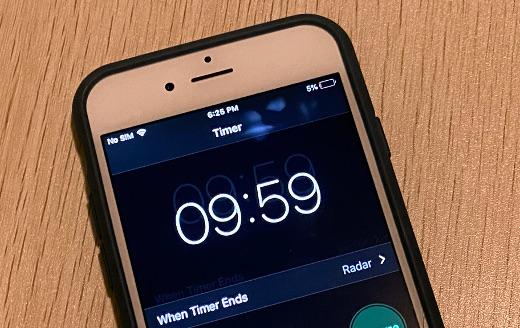
Consistency. Some say it is a sign of complacency, where whatever you do is merely repetition and there’s no change or innovation. I like to think consistency is more of a mindset than whatever it is you are executing upon. To this, I have a now defunct Chinese restaurant to thank.
When I last lived in the Boston area I was in the city of Waltham. It was a city of many faces – its past was industrial manufacturing, among other things the birthplace of the microwave oven, and now the home to universities and high-tech firms along Route 128. That transformation is not complete, as the neighborhood I lived in then was still in transition. I was just off of Moody Street, known as the city’s “restaurant row” as it was zoned for locally owned businesses and the home of some great non-chain restaurants.
Among those restaurants was Hong Kong, a take-out Chinese restaurants just around the corner from home off Moody Street. For myself and my newlywed wife, two working professionals, we frequented ordered from there. As one would expect from a local establishment, we got to know the manager and she always recognized us when we phoned in our ordered and picked it up. Sometimes an order was placed for just one of us, often times both, and we’d also order when entertaining friends. No matter the size of the order, no matter the time, the friendly voice of the manager told us the order would be ready in 10 minutes. Always 10, consistently.
For my wife and I, it was almost comical that any order would take the same amount of time no matter the quantity of food. We were only 10 minutes from a fresh, hot and delicious meal.
New Year, Same Consistency
Soon after moving to the Boston area many years before I learned of the “tradition” of ordering Chinese takeout for New Year’s Eve. The concept was then and likely still is now so popular that you had to place your order days in advance of December 31 to ensure you could get it that night. One New Year’s Eve my wife and I decided to stay in and watch Dick Clark and the ball drop in Times Square, and followed tradition and placed an order days in advance at Hong Kong.
When I went to Hong Kong to pick up our order at the appointed time, I was greeted with the usual warm welcome I was accustomed to from the owner. But the happy expression on her face quickly turned to concern as she told me that she did not have an order ready for me, though she remembers taking the order from me earlier in the week.
Grabbing a piece of paper, she retook my order and proceeded to the kitchen. What followed was a very spirited conversation in Chinese. I didn’t know if she and the cooks were yelling or what, but it was something reminiscent of my Italian heritage, just in another language. After a few minutes she came back to the front counter, smiling, and told me my order would be ready... in 10 minutes! On the busiest night of the year, and at the last minute no less. I took a walk around the block, came back for my order, and went home and told my wife the story as we dove into our delicious dinner.
Deconstructing Consistency
We often see consistency on the surface, however there is likely more as you dig deeper into it. Understanding your product or service, knowing yourself and a commitment to excellence are all part of what delivers consistency. Where the final output may be similar each time, under the hood there is a lot at play that is likely changing and adapting to ensure a consistent end result. Although the Hong Kong restaurant on Moody Street in Waltham, Massachusetts is long gone, its spirit lives on in my own commitment to delivering consistency, and adapting to ensure of it.
This is from The Hot Iron, a journal on business and technology by Mike Maddaloni.
Did you enjoy this? Subscribe to The Hot Iron by RSS/XML feed or Read by Email
Business • Strategize • Thrive • (0) Comments • PermalinkMy Takeaways From You Are Here For Now

For most people, where we are today is not where we were just a few years ago. For most, it is a state of mind, and a mind processing things we could have never anticipated. For some, they are physically in a different place, moving as a result of lockdowns and other personal reasons.
If I had a nickel for every time I heard – or said myself – that life is a journey, I would be on the beach right now and not gazing out at snow outside my window, but I digress. For as repetitive as it sounds, at least I need to keep hearing it, especially as a reminder when things are not going well or just outright suck.
In my mind, one of the best to say this is Adam J. Kurtz. He is the creative mind behind 1 Page At a Time and Things Are What You Make Them. Both are books to get you to think and the former is chock full of creative prompts. I am a big fan of AdamJK (for short), and when it was announced last year I pre-ordered his latest book, You Are Here *For Now.
You Are Here *For Now is a collection of short essays, quotes and art. Where at first glance it can be thought of as a self-help guide, I see it more of notes from a friend who is trying to help you go through the same crap as you are. As I have insightful family and friends that I am always taking away advice from, I have takeaways from this book too.
Pause – This is something this short-fused, 100% Italian-American needs to a lot more of. Maybe that pause is a deep breath or a walk along Lake Michigan (a favorite of mine when I lived in Chicago) or whatever works for you. A pause gives you time to think, get your heart rate down a little, and be more prepared for what you now have to deal with.
Hard But Not Impossible – Life is hard, sure, but not always impossible. In a world where waiting 30 seconds for food to heat in the microwave seems like an eternity, we need to adjust our thinking to better approach the hard work needed. The quotes and pictures in this book are a nice departure from simply a text narrative trying to motivate us.

It Won’t Last – Yes, Virginia, there is a light at the end of the tunnel, and what we’re going through right now will come to an end. Granted what’s next could even be worse, or it could be better. We’ll never know until we get there.
You Are Here *For Now is a pocket-sized book and one where you can easily rip out the pages and hang them up or give them to others. As a fan of AdamJK’s work, it should come as no surprise that I recommend you to pick up a copy of this book. Because I pre-ordered the book, I got this “Find Your Way” stationary kit, pictured below. Click on the picture or this link to see the photo of the kit full-sized. I wish when I was in college I had an eraser that was inscribed with, “I literally don’t know what I am doing!”
As I give away all books I read, including this one, I have earmarked it for Matt, a long-time reader and commenter here at The Hot Iron. I will send it to him as soon as he contacts me and tells me the best address to send it to.
This is from The Hot Iron, a journal on business and technology by Mike Maddaloni.
Did you enjoy this? Subscribe to The Hot Iron by RSS/XML feed or Read by Email
Book Take-Aways • (0) Comments • Permalink
